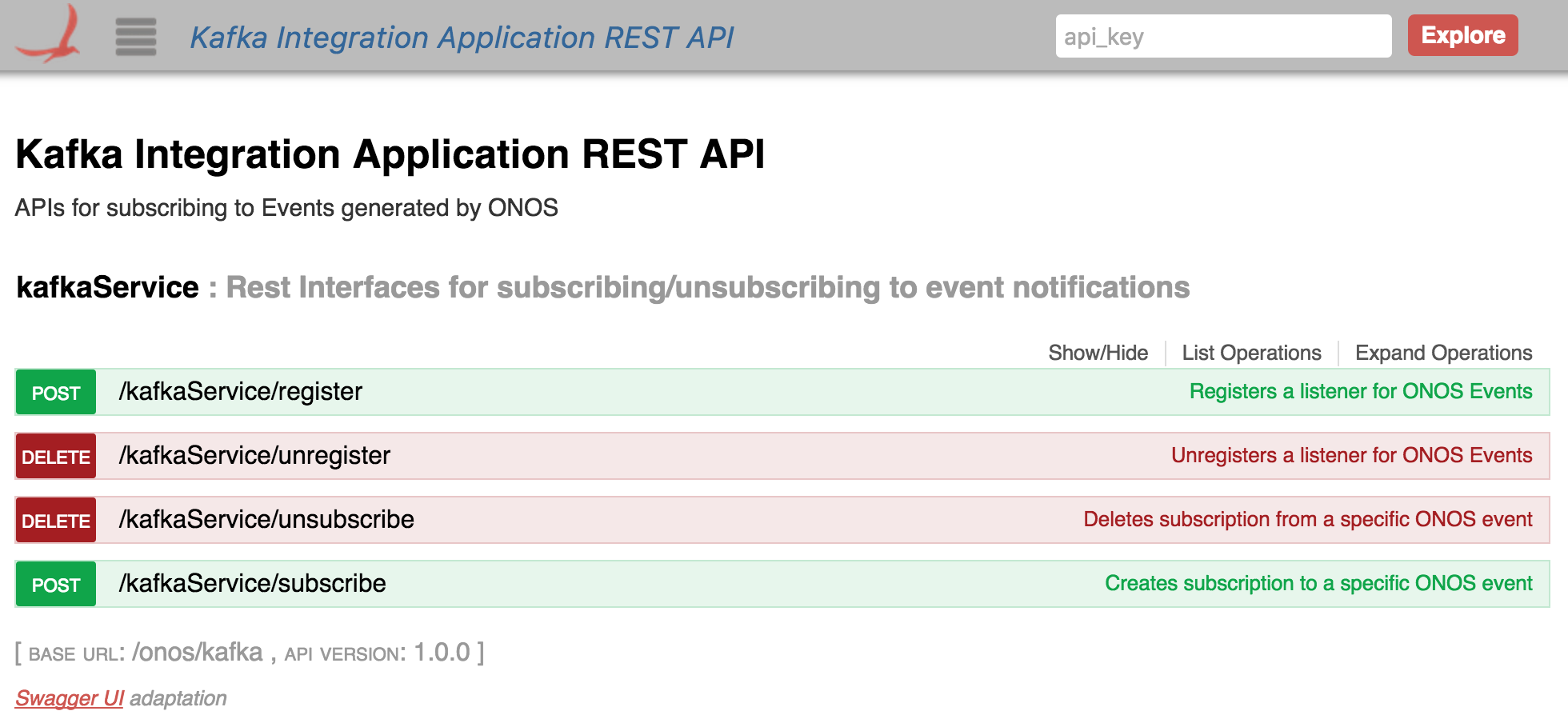...
- There will be one topic per event type. Each external app will be given a unique consumer groupId.
- Event subscription by external apps is a two step process - They must first register and then subscribe to a specific event call.
As a first step we will only export Device Events and Link Events to consumers and worry about Packet Ins and Packet Out later.
- Once the framework is in place it should be relatively easy to add support for other event types.
- In the scenario where the external app loses connectivity with the Kafka server, and does not come back up within the retention period (the time duration for which Kafka will retain messages) the onus is on the non native app to rebuild its current view of the network state via existing ONOS REST APIs.
DEVELOPER'S GUIDE
The following steps will walk you through connecting your app to ONOS and listening to specific ONOS events.
Build and run ONOS. This how-to screencast is a good starting point to build and run ONOS locally on your development machine, for any other information please refer to the ONOS Developer Guide.
Info title Important! Build using Maven Do not build using BUCK as the app currently does not support BUCK build. Use 'maven clean install' or mci (for the lazy ones like me).
Code Block language text $ mciActivate the Kafka integration app. This will activate all the modules of the app. In the ONOS command line, type:
Code Block language text $ app activate org.onosproject.kafkaintegrationCheck that RPC services and the ONOS Protobuf models have been activated too.
Code Block language text $ apps -s -aYou should see an output similar to this (depending on your defined startup apps in $ONOS_APPS) :
Code Block language text * 18 org.onosproject.drivers 1.7.0.SNAPSHOT Default Device Drivers * 27 org.onosproject.openflow-base 1.7.0.SNAPSHOT OpenFlow Provider * 28 org.onosproject.hostprovider 1.7.0.SNAPSHOT Host Location Provider * 29 org.onosproject.lldpprovider 1.7.0.SNAPSHOT LLDP Link Provider * 30 org.onosproject.openflow 1.7.0.SNAPSHOT OpenFlow Meta App * 41 org.onosproject.fwd 1.7.0.SNAPSHOT Reactive Forwarding App * 44 org.onosproject.incubator.rpc 1.7.0.SNAPSHOT ONOS inter-cluster RPC service * 45 org.onosproject.incubator.protobuf 1.7.0.SNAPSHOT ONOS ProtoBuf models * 51 org.onosproject.kafkaintegration 1.7.0.SNAPSHOT Kafka Integration Application * 58 org.onosproject.mobility 1.7.0.SNAPSHOT Host Mobility App * 81 org.onosproject.proxyarp 1.7.0.SNAPSHOT Proxy ARP/NDP App- Register your app using Swagger API. You will want to register your app to listen to specific ONOS events using Swagger API.
The link to Swagger UI is: http://127.0.0.1:8181/onos/v1/docs/#/ and the username and password, both are: karaf
You have to select 'Kafka Integration Application REST API' from the selection menu on the top which is default set on 'ONOS Core REST API.'
The following image displays what POST and GET operations will be available for your use.
In the register POST operation, input the name of your app, and hit on 'Try it out!' - The Response Body consists of the JSON generated from the call. It consists of the GROUP_ID, KAFKA_IP and KAFKA_PORT.
It would look something like this:
The KAFKA_IP and the KAFKA_PORT are to be passed as a parameter to the "bootstrap.servers" Kafka property of your app.
Use the GROUP_ID to subscribe for ONOS events using the Swagger UI. Subscribe for ONOS events. In the subscribe POST operation, create a subscription to a specific ONOS event. A model schema exists on the right-hand side of the call.
The appName would be the same name of the app, with which you registered. The groupId would be the groupId you get as a response after registering your app and the eventType would be the type of the ONOS events you want to register for (LINK and DEVICE events for now).Info title Errors with Swagger responses There is a possibility that the Swagger UI might give wrong responses, like 'No response from server.' In such cases, please check your log to be sure of the correct response. To print your log, you can use the following command in a new Terminal window.
Code Block language text $ tlFor a successful subscription you should get a 'Subscription for DEVICE event by forwardingApp successful' message.
- Successfully receive the specific ONOS events. After your event subscription is completed, you should receive the specific ONOS events successfully.
FAQ
- Is it possible that before Kafka Integration App tries to create a topic, the external app can try to subscribe to that topic?
Yes, this is possible. In such a scenario Kafka will automatically create the topic. This is similar to the case where the
producer tries to publish a message to a non existent topic. Kafka will create a topic automatically. - What is the purpose of having a Group Id and App name info in the POST REST call?
GroupId is necessary to make sure there is no conflict among multiple external apps. When the external apps tries to consume data
each app should be in a separate consumer group. This way the message is delivered to all the external apps from a single topic. The
App name is primarily for keeping track of which apps have registered. May be we could have a GET REST call to show the current registered apps. - How does the external app know what event types are supported ?
A GET REST API will be provided to show the list of events supported - How does the external app know how many partitions were created for the topic?
This I am thinking will be sent as part of the response to the POST call. The external
app needs this information, so it can spin up appropriate number of threads.
(Num of Consumer Threads = Num of Partitions) - What is the topic name that gets created?
The topic name is the same as event type.
...

